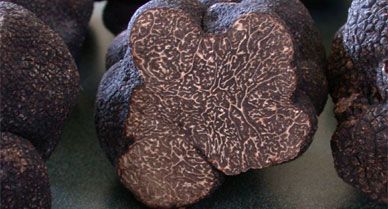For Hire: Truffle Hunter
Into the weird world of mushroom delicacy
/https://tf-cmsv2-smithsonianmag-media.s3.amazonaws.com/filer/truffle631.jpg)
Charles Lefevre is an addict. And a clever one at that, because he's devised a way to sustain himself and the object of his addiction: mushrooms. Lefevre's fungus of choice is the truffle, arguably the most elegant and priciest type of all. The 42-year-old runs New World Truffieres Inc., which produces trees inoculated with truffles that farmers can use to start "truffieres"—or truffle orchards. The business, based in Oregon's Willamette Valley, began in 2000, and Lefevre now has customers across the continent. In addition to selling the trees, he helps organize the Oregon Truffle Festival in late January, when the mushrooms are at their best. Lefevre tells Smithsonian.com how he finds the fun in fungus.
What exactly are truffles?
Truffles are mushrooms that develop underground and depend on animals eating them to disperse their spores. They actually need for us to eat them to complete their life cycle. Since they live below ground, they can't turn red like an apple to get our attention. Instead, they produce powerful aromas to attract our attention from several inches underground.
How did you get interested in them?
Truffles are mysterious and magical; they have that kind of leprechaun quality. Truffle hunting is something I did to supplement my income as a graduate student at Oregon State University. I am a mycologist [his PhD is in forest ecology], so hunting for chanterelles and porcini was what I did for fun anyway. At some point, it was hard to separate my academic and entertainment interests.
So, without divulging trade secrets of course, what do you do?
We produce trees inoculated mainly with the European truffles to enable farmers here in the United States to grow the famous European truffles. The truffles and the trees form a mutually beneficial symbiosis that can last 50 years or more in the soil. The trees are produced under controlled conditions for the first year of their lives in order to convince them and the truffles to form their symbiosis. It is a delicate process since the needs of the fungus and the needs of the trees are not entirely the same.
Who are your customers?
The people who purchase the trees are demographically similar to the people who pioneered the wine industry in this country: they are mainly professionals looking for a lifestyle change who can afford to venture into new areas of agriculture that offer some mystique as well as the potential for significant income. Our customers are spread all over the continent, and I do visit them when I'm asked to do site evaluations.
Is there a hunting season?
January to June.
When you're hunting, how do you find truffles?
Out here, we look for them with rakes; that's the bad harvesting practice you hear about.
Why is that bad?
You're raking up the forest floor and all the things that live on it. It doesn't allow you to choose ripe, harvestable truffles, so you'll rake up immature and unripe ones. That damages the taste and the reputation.
Why don't hunters here use pigs and dogs like they do in Europe?
Most of the hunting is done surreptitiously at night without [a landowner's] permission. If you're driving around with a pig, everyone knows what you're doing.
I've been hunting with dogs, and they're preferable. Any dog can find truffles, but dogs that love to work are best. Labs and poodles make great truffle dogs.
How many truffle hunters are there?
There are very few truffle hunters in the United States. It is a secretive business, and perhaps only a thousand people in the Northwest know how and where to look for them. Of that thousand, perhaps 20 people do 90 percent of the harvesting. Globally, I have no idea; there are undoubtedly many thousands in France, Italy and Spain.
What's it take to be a good truffle hunter?
The principal personality trait required is the ability not to brag about it, because someone will follow you to your patch the next time you go.
And can a good patch be a veritable leprechaun's pot of gold?
Native Oregon truffles are under-priced at about $100 per pound, although they sold for as much as $200 per pound last year. The European black truffles typically sell for about $800 per pound wholesale here in the U.S., and the Italian white truffles are often in the neighborhood of $1500 per pound wholesale. Truffle hunting is a hard life if that's all you do to make a living. It's a bit like prospecting for gold; most people don't make much money and move quickly on to other things. But a few do quite well.
How are truffles different?
The Oregon white truffles have a powerful gassy aroma that goes very well in anything with a cream sauce. The Oregon black truffles have a distinctive tropical fruit aroma often described as pineapple or mango that goes very well in desserts, particularly ice cream. The European black truffle has a musky, but slightly sweet aroma that is famous with omelets. The Italian white truffle is powerfully musky, even a bit raunchy, and is famous simply shaved over pasta.
So how does an aficionado like you eat truffles?
Simple is best; pasta in a cream sauce with shaved white truffles on top.
Robin T. Reid is a regular contributor to Smithsonian.com.
/https://tf-cmsv2-smithsonianmag-media.s3.amazonaws.com/accounts/headshot/eric-jaffe-240.jpg)


/https://tf-cmsv2-smithsonianmag-media.s3.amazonaws.com/accounts/headshot/eric-jaffe-240.jpg)